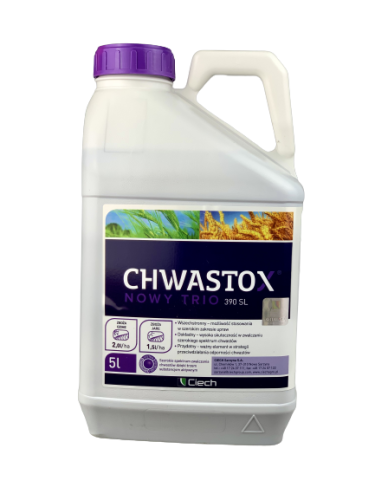AgroBenelux
MCPP Chwastox Nowy Trio 390SL 5L
MCPP Chwastox Nowy Trio 390SL 5L
Couldn't load pickup availability
Description
CHWASTOX NOWY TRIO 390 SL
Volume: 5l
Selective herbicide for controlling annual broadleaf weeds in spring and winter cereals, as well as on lawns, sports fields, and golf courses.
Chwastox Nowy Trio 390 SL is a systemic, selective herbicide applied post-emergence. It is a liquid formulation for preparing an aqueous solution, intended to control broadleaf weeds in winter wheat, winter triticale, rye, spring barley, oats, and on turf grass areas including sports pitches and golf courses. According to the HRAC classification, the active substances MCPA, mecoprop-P, and dicamba belong to Group O.
Active ingredients (per liter):
-
MCPA (potassium salt – phenoxy acid group): 200 g/L (16.7%)
-
Mecoprop-P (MCPP) (potassium salt – phenoxy acid group): 150 g/L (12.5%)
-
Dicamba (potassium salt – benzoic acid derivative): 40 g/L (3.3%)
Benefits of using Chwastox Nowy Trio 390 SL:
✔️ Effective control of weeds in turfgrass
✔️ Broad weed spectrum thanks to 3 active ingredients
✔️ Flexible application window
✔️ No observed weed resistance with long-term use
Mode of action:
The herbicide is absorbed through the leaves, causing deformation, growth inhibition, and death of susceptible weeds. It is most effective against weeds in early growth stages – from seedling to 9-leaf whorl (BBCH 11–19). Favorable weather for crop growth enhances the herbicidal action.
Target Crops and Weeds Controlled
Winter wheat, winter triticale, rye, winter barley
Dose: 2.0 L/ha
Susceptible weeds:
cornflower, fumitory, wild mustard, chickweed, stork's-bill, lamb's quarters, poppy, scentless mayweed, field forget-me-not, rough nettle, cleavers, hedge bindweed, mayweed, common chamomile, volunteer oilseed rape, shepherd’s purse, field pennycress
Moderately susceptible weeds:
small-flowered cranesbill, field pansy, ground ivy
Spring barley, spring wheat, oats, spring triticale
Dose: 1.5 L/ha
Susceptible weeds:
fumitory, wild mustard, chickweed, purple deadnettle, lamb's quarters, poppy, scentless mayweed, rough nettle, cleavers, bindweed, mayweed, rough pigweed, shepherd’s purse, field pennycress, small-flowered galinsoga
Moderately susceptible weeds:
small-flowered cranesbill, cornflower, field pansy, forget-me-not, volunteer oilseed rape
Recreational turf areas (lawns, sports fields, golf courses)
Dose: 2.0 L/ha
Susceptible weeds: creeping buttercup, common dandelion, smooth hawksbeard, common mouse-ear, common sorrel
Moderately susceptible weeds: narrowleaf plantain, broadleaf plantain, yarrow
Resistant weeds: small-flowered cranesbill, white clover, speedwell, field speedwell
Double application for recreational turf (2.0 L/ha x2):
Controls: narrowleaf and broadleaf plantain, small-flowered cranesbill, creeping buttercup, white clover, yarrow, dandelion, hawksbeard, speedwell, mouse-ear, sorrel
Resistant: ground ivy (speedwell)
Dosage & Application
Apply using self-propelled, tractor-mounted, or handheld sprayers.
Winter cereals (wheat, rye, triticale, barley)
-
Max/Recommended dose: 2.0 L/ha
-
Timing: In spring, from the beginning to the end of tillering (BBCH 21–29)
-
Max applications per season: 1
-
Water volume: 200–300 L/ha
-
Spray type: Medium-droplet
Spring cereals (wheat, barley, oats, triticale)
-
Max/Recommended dose: 1.5 L/ha
-
Timing: From the beginning to the end of tillering (BBCH 21–29)
-
Max applications per season: 1
-
Water volume: 200–300 L/ha
-
Spray type: Medium-droplet
Lawns, sports fields, golf courses
-
Max/Recommended dose: 2.0 L/ha
-
Timing: From spring to early autumn, on weeds from 4-leaf to flowering stage (BBCH 14–40)
-
Apply across entire surface or spot treat
-
Repeat treatment: If weed pressure is high, a second application may be required
-
Interval between applications: Minimum 56 days
-
Water volume: 500 L/ha
-
Spray type: Medium-droplet
Important application notes:
-
Do not mow turf for at least 7 days before and after spraying
-
Weed control is possible in the establishment year once the grass is fully tillered
-
Avoid spray drift to trees, shrubs, leaves, or green bark to prevent damage
-
Do not use treated plants for animal feed in the year of treatment
Crop Rotation / Reseeding
If crop failure occurs (e.g. due to frost, pests, or disease), any crop may be sown after pre-sowing cultivation.
⚠️ Important Warnings
-
Use herbicide rotation and mixtures with different modes of action
-
Never apply more than one product with the same mode of action per growing season
-
Avoid:
-
Drift to neighboring crops (especially broadleaf species)
-
Overlapping at spray swaths or field edges
-
Contamination of irrigation water
-
Do not apply:
-
During drought
-
To diseased, damaged, or wet plants
-
At temperatures below 10°C or above 25°C
-
Before imminent frost or rain
-
In windy conditions that may cause drift
Share

Zeer snelle en correcte levering
Zeer goed product, snelle verzending

